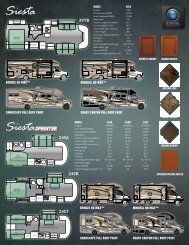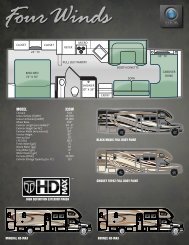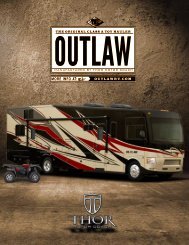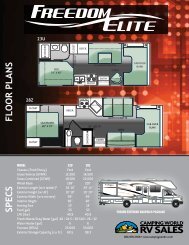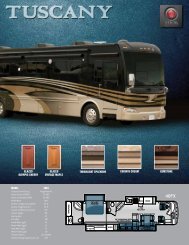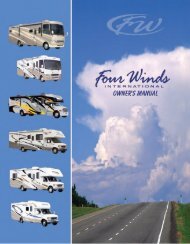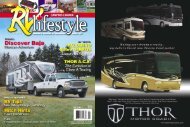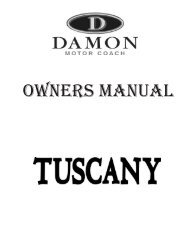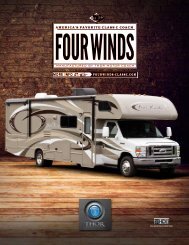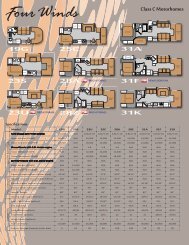2006 Mandalay Motorhome Owners Manual - Thor Motor Coach
2006 Mandalay Motorhome Owners Manual - Thor Motor Coach
2006 Mandalay Motorhome Owners Manual - Thor Motor Coach
Create successful ePaper yourself
Turn your PDF publications into a flip-book with our unique Google optimized e-Paper software.
IDENTIFICATION & SAFETY<br />
How to Test<br />
Never use an open flame of any kind to test this unit. The built-in test switch accurately<br />
tests the unit’s operation as required by Underwriters Laboratories, Inc. (UL).<br />
Simply press the TEST switch any time during the warm-up cycle or while in normal<br />
operation. The LED should flash red and the alarm should sound. Release the switch. This is<br />
the only way you should test your detector. The test feature checks the full operation of the<br />
detector. If this detector does not test properly return it immediately for repair or replacement.<br />
TEST: This test procedure should be repeated every week or every time the motorhome is<br />
taken on a trip, whichever occurs first.<br />
REFERENCE: Refer to the manufacturer’s Owner’s <strong>Manual</strong> or all the detector manufacturer,<br />
if you have any questions about the LP Gas Detector.<br />
Checking the LP Gas System for Leaks<br />
Never check for leaks with an open flame. The scent of LP Gas (a garlic-like odor) is<br />
actually ethyl mercaptan, an additive that allows you to detect the presence of a leak,<br />
since LP Gas is naturally odorless. Do not rely upon being able to detect the smell of the<br />
gas, as the odor may fade.<br />
Road vibration can loosen LP Gas fittings. It is important to check the LP system for leaks at<br />
least every 5,000 miles, and whenever the tank is filled. It is also a good idea to have the entire<br />
LP Gas system checked annually by a qualified LP Gas service representative.<br />
Use the following steps when checking the system for leaks:<br />
3-10<br />
1. Open all the windows and vents.<br />
2. Open the gas tank service valve.<br />
3. Use non-ammoniate, non-chlorinated soap solution, or an approved leak detection<br />
solution on all line connections (ammoniate soap solutions can cause cracking on<br />
copper or brass lines and fittings).<br />
4. If a leak is detected, tighten the connection with two open end wrenches until<br />
bubbling stops. DO NOT over tighten, or use excessive force. If the leak continues,<br />
contact the recreation vehicle dealer, or a qualified LP Gas service representative to<br />
have an 11" Water Column Test performed.<br />
MANDALAY



